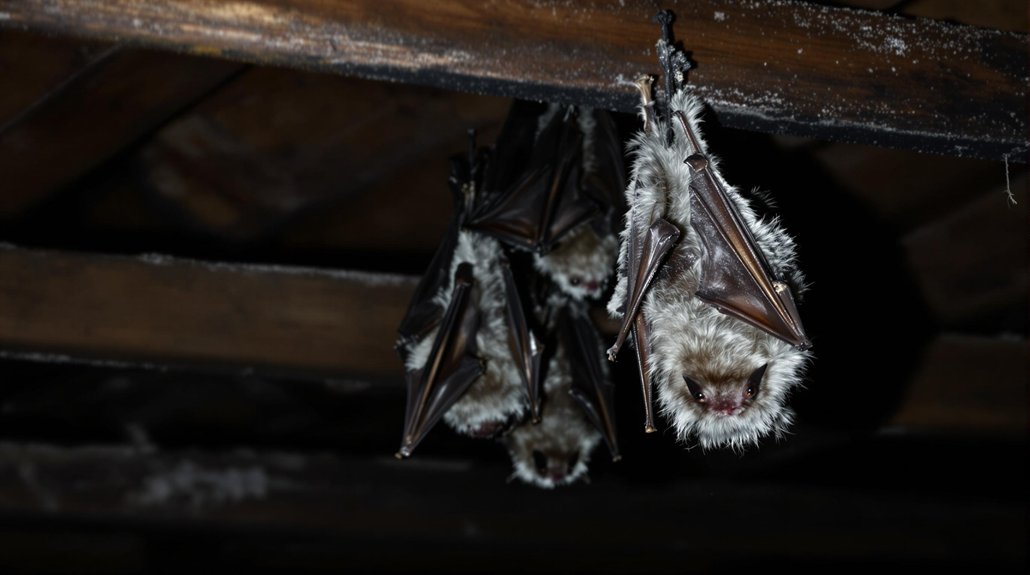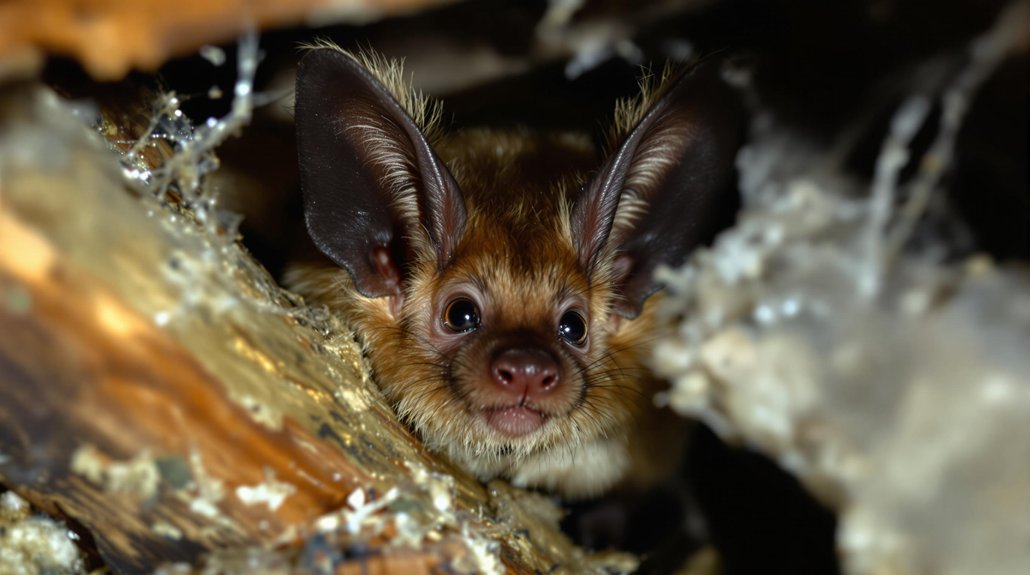Common bat species found in Texas attics include Mexican Free-Tailed Bats, Big Brown Bats, and Little Brown Bats. Mexican Free-Tailed Bats prefer warm spots and form large colonies. Big Brown Bats roost in attics and consume various insects. Little Brown Bats are small and often found in dark areas. Other species like Hoary Bats, Silver-Haired Bats, Evening Bats, and Fringed Myotis also reside in these spaces. More information about their habits and management is available.
Key Article Highlights
- Mexican Free-Tailed Bats often roost in attics, forming large colonies and primarily feeding on insects.
- Big Brown Bats frequently choose attics for roosting, using echolocation to navigate and hunt for pests.
- Little Brown Bats prefer warm, dark spaces like attics and are essential for controlling insect populations.
- Hoary Bats may roost in attics or trees, primarily preying on moths and insects.
- Evening Bats are social and often roost in groups within attics, emerging at dusk to hunt for flying insects.
Overview of Bats in Texas
Although bats are often misunderstood, they play a crucial role in the ecosystem of Texas. The state is home to many bat species, each contributing to the environment in unique ways. Bats help control insect populations, which benefits crops and gardens. They are also important for pollination and seed dispersal. Many bats seek shelter in attics, especially during warmer months. Their attic entry can lead to conflicts with homeowners who may not appreciate their presence. It is essential to understand that these creatures are generally harmless and prefer to avoid humans. By respecting their role in nature and learning about their habits, people can coexist with bats while enjoying the benefits they bring to Texas. Understanding bat behavior can help homeowners prevent unwanted encounters and ensure safe, humane exclusion methods.
Mexican Free-Tailed Bats
Mexican free-tailed bats are common in Texas. They prefer to roost in warm places like attics and caves. These bats feed mostly on insects, making them important for controlling pest populations.
Habitat Preferences
While many bats prefer natural roosts, Mexican free-tailed bats often choose man-made structures for their habitat. These bats show specific bat preferences that lead them to roost in attics, bridges, and buildings. They thrive in warm, dry spaces that provide shelter and protection. Mexican free-tailed bats are known to form large colonies, making these habitat types ideal for their social structure. The presence of nearby open areas allows them to easily take flight. These bats are adaptable and will seek out locations that offer safety and comfort. By choosing man-made environments, they can coexist with humans while finding suitable places to roost during the day. This unique choice reflects their flexibility in habitat preferences.
Feeding Habits
Feeding habits of Mexican free-tailed bats are primarily focused on insects. Their bat diet consists mostly of moths, beetles, and other flying insects. These bats are known for their impressive insect consumption. They can eat thousands of insects in a single night, helping to control pest populations.
| Insect Type | Common Species | Consumption Rate |
|---|---|---|
| Moths | Gypsy moth | High |
| Beetles | Ladybug | Moderate |
| Flies | Housefly | High |
| Mosquitoes | Common mosquito | Moderate |
This diet allows Mexican free-tailed bats to thrive in various environments. Their role as insectivores is essential for maintaining a balanced ecosystem.
Roosting Behavior
Roosting behavior of Mexican free-tailed bats is fascinating and essential for their survival. These bats have specific roosting habits that help them thrive. They prefer certain locations that provide safety and comfort.
- Under bridges: This offers shelter from predators and harsh weather.
- In caves: Natural formations allow them to roost in large groups.
- In attics: Buildings provide warmth and protection from the elements.
- In trees: They find crevices and hollows that shield them from dangers.
Mexican free-tailed bats often choose roosting locations that maximize safety and minimize disturbance. Understanding these habits helps guarantee their protection and coexistence with humans. Their unique choices reflect their need for freedom and security in their environment.
Big Brown Bats
Big brown bats are common in Texas and often prefer to roost in attics and other sheltered areas. They feed mainly on insects, using their echolocation to find food at night. Understanding their habitat preferences and feeding habits can help homeowners manage bat populations effectively.
Habitat Preferences
Many bats, including the Big Brown Bat, prefer certain habitats for their survival and reproduction. These bats have specific attic preferences and thrive in environments that offer safety and shelter. Their choices often include:
- Old buildings: Big Brown Bats like to roost in abandoned structures.
- Attics: They often choose attics due to warmth and protection.
- Caves: Natural caves provide a dark, safe space for roosting.
- Tree hollows: These offer a natural habitat that mimics their needs.
Understanding bat habitats is essential for maintaining a balance in nature. By knowing where Big Brown Bats prefer to live, people can coexist with them peacefully and protect their essential roles in the ecosystem.
Feeding Habits
While foraging at night, Big Brown Bats primarily feed on insects, making them valuable for pest control. Their bat diet consists mainly of beetles, moths, and flies. These bats use echolocation to find their food in the dark, showcasing their impressive foraging habits.
| Insect Type | Importance to Diet |
|---|---|
| Beetles | Major food source |
| Moths | High in protein |
| Flies | Easy to catch |
| Ants | Supplementary food |
| Lacewings | Nutritional variety |
Little Brown Bats
Little brown bats, often found roosting in attics, play an important role in the ecosystem. These bats have distinct characteristics that make them unique. Here are some key features:
- Size: They are small, typically measuring 3 to 4 inches in length.
- Color: Their fur is brown, often with lighter underparts.
- Diet: They primarily eat insects, helping control pest populations.
- Habitat: They prefer warm, dark spaces like attics for roosting.
Little brown bat conservation is essential as their numbers have declined due to various threats, including habitat loss and diseases. Protecting these bats helps maintain healthy ecosystems and supports biodiversity. Recognizing their value fosters a deeper appreciation for wildlife in Texas.
Hoary Bats

Hoary bats are another species commonly found in Texas. They are known for their large size and distinctive fur, which is dark with white tips. This gives them a frosted appearance. Hoary bats are solitary and prefer to roost in trees, but they may also find shelter in attics. Their diet mainly consists of moths and other insects, making them beneficial for pest control. Hoary bat conservation is important as their populations face threats from habitat loss and wind turbines. Protecting their habitats and raising awareness about their role in the ecosystem can help guarantee their survival. Understanding hoary bat characteristics can aid in recognizing their presence and promoting efforts for their conservation in Texas.
Eastern Red Bats
Eastern red bats are commonly found in wooded areas and often roost in trees. They are known for their unique hunting skills, using their keen senses to catch insects at night. Understanding their habitat and behavior can help people learn more about these fascinating creatures.
Habitat and Behavior
Although many bats prefer dark caves or old buildings, Eastern Red Bats often seek refuge in trees. These bats are known for their unique habits and behaviors. They typically roost alone or in small groups, hanging beneath leaves for protection. Their choice of bat habitats includes:
- Deciduous forests
- Suburban areas with trees
- Open woodlands
- Parks and gardens
Eastern Red Bats are active at night, flying through the air to catch insects. They are solitary creatures, valuing their freedom. Their behavior is influenced by the seasons, as they migrate to warmer areas during colder months. Understanding their habitat and behavior is essential for managing bat populations in Texas attics and surrounding areas.
Diet and Foraging Techniques
Bats, including the Eastern Red Bat, have specific dietary needs that influence their foraging habits. Their diet primarily consists of insects, which provide essential bat nutrition. They often employ various foraging strategies to find food.
| Insects Eaten | Foraging Time | Hunting Method |
|---|---|---|
| Moths | Dusk to Dawn | Aerial Hawking |
| Beetles | Evening | Gleaning |
| Flies | Night | Pursuit |
Eastern Red Bats hunt in wooded areas and open spaces. They fly slowly, listening for sounds of insects. This helps them locate their meals effectively. Understanding their diet is vital for appreciating these bats and their role in the ecosystem.
Silver-Haired Bats
Silver-haired bats are a unique species found in Texas attics. They are known for their striking appearance and behavior. Here are some key points about silver-haired bats:
- Silver-haired characteristics: Their fur has a distinctive silver sheen, giving them their name.
- Size: They are small to medium-sized bats, typically measuring about 3 to 4 inches in length.
- Habitat: Silver-haired bats prefer wooded areas but often seek shelter in attics for warmth and safety.
- Silver-haired range: Their range extends across the eastern and western United States, including many parts of Texas.
These bats contribute to the local ecosystem and can be an interesting sight for those who encounter them in their homes.
Evening Bats
Evening bats are another species commonly found in Texas attics, where they seek refuge and warmth. These bats are known for their social behavior, often roosting in groups. They usually emerge at dusk, flying out to hunt for insects. Their evening bat diet mainly consists of moths, beetles, and other flying insects. This diet helps control pest populations, making them beneficial to the environment. Evening bats are agile flyers, able to catch prey mid-air. They prefer warmer areas, which makes attics an ideal home. Their presence can indicate a healthy ecosystem, as they play an important role in nature. Understanding evening bat behavior and diet can help homeowners appreciate these creatures and their positive impact.
Fringed Myotis

Fringed myotis are another bat species that can be found in Texas attics. These bats have unique features that make them interesting. Here are some key points about them:
Fringed myotis, with their unique features, are fascinating bats often found in Texas attics.
- Fringed myotis characteristics: They have long, fringed hair on their wings.
- Size: They are medium-sized bats with a wingspan of about 11 to 13 inches.
- Diet: Their diet mainly consists of insects, which they catch in flight.
- Fringed myotis distribution: They are commonly found across Texas and other parts of the southwestern United States.
Fringed myotis play a role in the ecosystem by controlling insect populations. Their presence in attics can indicate a nearby roost. Understanding these bats helps in appreciating their role in nature.
Managing Bat Presence in Your Attic
When bats take up residence in an attic, it is important to manage their presence effectively. Homeowners should use bat exclusion techniques to prevent bats from re-entering. This involves sealing all entry points, such as cracks and gaps. It is vital to guarantee that all bats are out of the attic before sealing these openings. Humane removal methods are recommended to relocate bats safely without harm. It is best to contact wildlife experts who specialize in this process. They can provide guidance and assistance. Using professional bat control services ensures the proper and humane removal of bats. By adopting these practices, homeowners can enjoy their space again while respecting the wildlife. Managing bat presence is essential for a safe and comfortable home environment.
Frequently Asked Questions
Are Bats Harmful to Humans or Pets?
Like shadows in the night, bats can pose health risks to humans and pets. Bat health risks include rabies, which can threaten pet safety. Keeping a safe distance guarantees both people and animals remain unharmed.
How Can I Tell if Bats Are in My Attic?
To determine if bats are in an attic, one should look for bat signs such as droppings or stains. Regular attic inspections can help identify these signs and confirm the presence of bats.
What Sounds Do Bats Make at Night?
Bats communicate through high-pitched sounds, squeaks, and chirps, reflecting their nocturnal behavior. These noises serve as a language for navigation and social interaction, revealing their presence and activity during the quiet hours of the night.
Are Bats Protected by Law in Texas?
In Texas, bats are protected by law due to their importance in bat conservation and maintaining healthy bat habitats. These laws help guarantee their survival, allowing ecosystems to thrive while granting people freedom to coexist with wildlife.
How Can I Safely Remove Bats From My Attic?
To safely remove bats, one should consider humane removal techniques. This includes sealing entry points and using bat exclusion methods. It guarantees bats leave without harm, promoting both safety and the well-being of the animals.

